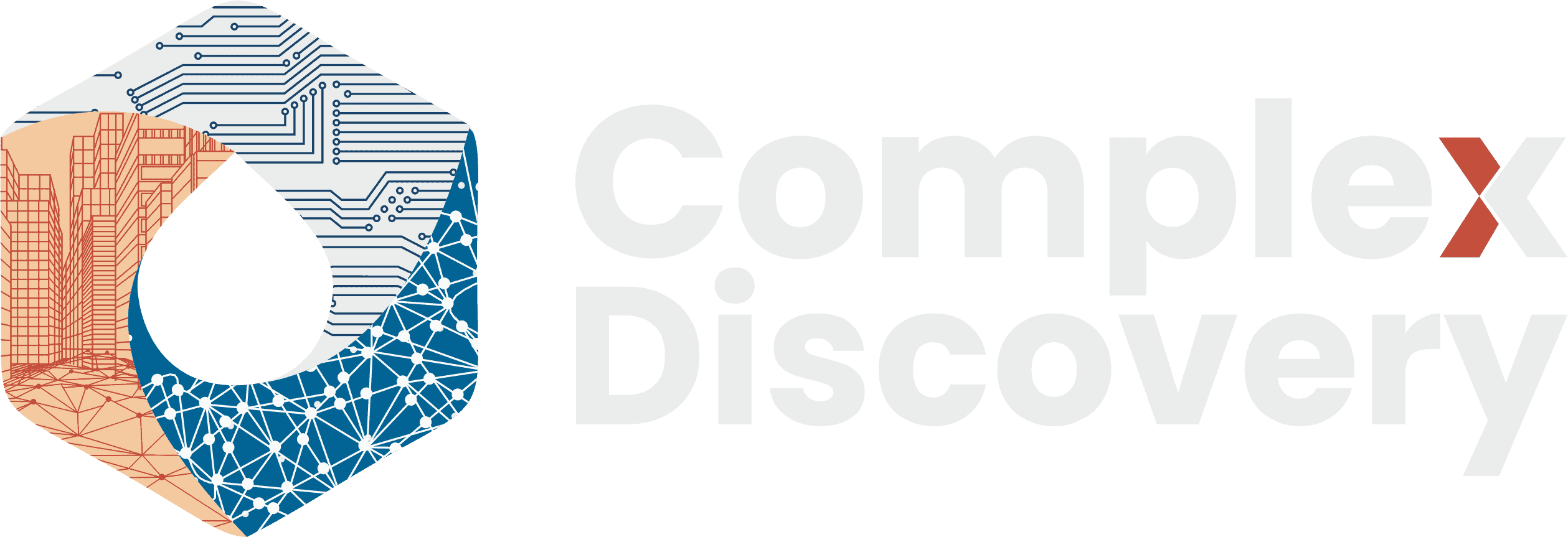Editor’s Note: The 1H 2025 eDiscovery Business Confidence Survey marks the 37th edition of this trusted industry snapshot, drawing insights from 77 professionals across the legal, technology, and corporate spectrum. Since its inception in 2016, the survey has collected 3,528 responses, averaging approximately 95 participants per edition. In recognition of the increasing number of industry research initiatives, the survey adopted a semi-annual cadence in 2025, ensuring ongoing relevance while reducing frequency.
Conducted through the collaborative efforts of ComplexDiscovery OÜ and the EDRM, this edition ran from April 10 through May 3, 2025. The survey methodology focused on targeted efficiency, seeking to secure at least 50 responses through modest outreach to professional networks within both organizations. This disciplined approach helped reduce respondent fatigue while achieving a meaningful sample for assessing industry sentiment and trends.
With robust input and a forward-looking perspective, this survey continues to serve as a key resource for cybersecurity, information governance, and eDiscovery professionals. As generative AI adoption accelerates and business models evolve, these insights offer a valuable compass for navigating a dynamic and data-intensive landscape.
Content Assessment: 1H 2025 eDiscovery Business Confidence Survey Results Released by ComplexDiscovery OÜ and EDRM
Information - 95%
Insight - 94%
Relevance - 96%
Objectivity - 94%
Authority - 97%
95%
Excellent
A short percentage-based assessment of the qualitative benefit expressed as a percentage of positive reception of the recent article from ComplexDiscovery OÜ titled, "1H 2025 eDiscovery Business Confidence Survey Results Released by ComplexDiscovery OÜ and EDRM."
Industry Research
1H 2025 eDiscovery Business Confidence Survey Results Released by ComplexDiscovery OÜ and EDRM
ComplexDiscovery Staff
Executive Summary
The 1H 2025 eDiscovery Business Confidence Survey presents a detailed and data-rich view of market conditions, operational challenges, and strategic signals within the evolving eDiscovery ecosystem. Based on the input of 77 professionals, predominantly from U.S.-based organizations, the survey illustrates a sector grounded in stability yet energized by emerging technologies such as generative artificial intelligence (GAI) and large language models (LLMs).
More than half of respondents (51.95%) describe current business conditions as “normal,” while 37.66% find them “good.” Looking ahead, 31.17% anticipate improvements in the next six months, suggesting cautious optimism. Budgetary constraints (36.36%) remain the foremost perceived threat, followed by data management complexity related to increasing types and volumes of information.
Technological disruption is both a challenge and a beacon of innovation. A majority (57.14%) of organizations report active deployment of GAI and LLM technologies, with the primary expected benefit being improved service/product delivery. However, concerns remain about result accuracy, implementation costs, and regulatory compliance.
Financial and operational awareness is mixed. While 35.21% report increasing monthly recurring revenue (MRR), 44.29% lack clarity on Days Sales Outstanding (DSO) trends, indicating a potential gap in financial visibility.
This edition of the survey underscores a maturing industry—one that is managing legacy constraints while making deliberate strides into a more automated, data-driven future.
Introduction
As legal technology continues its integration with AI-driven innovation and data complexity intensifies, the eDiscovery sector finds itself navigating a pivotal moment. The 1H 2025 eDiscovery Business Confidence Survey, conducted by ComplexDiscovery OÜ and the EDRM, offers a multifaceted exploration of industry sentiment, technological adoption, and strategic positioning. With representation across legal, software, consulting, and corporate sectors, the survey captures both leadership vision and day-to-day operational realities.
Business Composition and Industry Representation
Among the 77 respondents, software and services providers account for the largest segment at 40.26%, followed by law firms (25.97%), consultancies (11.69%), and corporations (10.39%). Smaller but still important contributions come from media/research organizations (6.49%) and governmental entities (5.19%).
Geographically, the results are overwhelmingly U.S.-centric, with 96.1% of respondents conducting their primary eDiscovery work in the United States. The remaining responses—just one each from Canada, the UK, and Europe ex-UK—highlight a significant gap in international perspectives and reaffirm the U.S. market’s centrality.
Role diversity within organizations is well distributed. Respondents span tactical (35.06%), operational (33.77%), and executive (31.17%) tiers, ensuring that the survey reflects not only strategic planning but also the challenges and opportunities faced by practitioners on the ground.
These figures confirm a market led by legal and technology service providers, centered in North America, and deeply engaged across all levels of business operation.
Market Sentiment and Business Conditions
Stability characterizes the current eDiscovery business landscape, as 51.95% of respondents describe conditions in their segment as “normal.” Another 37.66% rate conditions as “good,” while only 10.39% view them as “bad.” This baseline stability sets the stage for future confidence.
When asked about the outlook six months ahead, a majority (51.95%) foresee continuity, while a notable 31.17% expect improved conditions. This blend of steadiness and measured optimism suggests that while few anticipate a market surge, many are positioning for progressive gains.
Financial forecasts align with these sentiments. Half of the respondents (50.65%) anticipate stable revenue, while 31.17% expect growth, and 18.18% anticipate a decline. Profit expectations follow a similar arc: 57.14% see profits holding steady, 25.97% project increases, and 16.88% foresee decreases.
Together, these insights depict a maturing market that values predictability but is open to strategic innovation, particularly among organizations with lean operating models and scalable offerings.
Core Challenges and Strategic Risks
When evaluating near-term risks, budgetary constraints dominate. Selected by 36.36% of respondents, cost pressures continue to limit flexibility in staffing, technology acquisition, and expansion. This challenge is particularly acute in sectors undergoing transformation or dealing with highly variable case volumes.
Data-related challenges—specifically, the growing diversity (22.08%) and volume (18.18%) of electronically stored information (ESI)—form the second tier of concern. Together, over 40% of respondents emphasize these issues, reflecting the ongoing evolution of data sources beyond email to include messaging apps, collaboration tools, and unstructured data.
Security issues (10.39%), technological limitations (9.09%), and personnel shortages (3.90%) round out the risk profile, illustrating that foundational concerns still persist in the backdrop of innovation.
These concerns point to a sector where operational resilience and intelligent resource allocation are vital. For professionals managing budgets, technology roadmaps, or client deliverables, understanding these friction points helps in prioritizing investments and preparing for complexity.
Technology Adoption: Generative AI and LLM Integration
The 1H 2025 survey reveals an inflection point for AI-driven transformation. A substantial 57.14% of organizations report active integration or deployment of GAI and LLM solutions. Another 15.58% are piloting these tools, and 18.18% are in the evaluation phase. Only 9.09% currently have no plans for AI adoption.
The most commonly cited benefit is improved service or product delivery, identified by 46.75% of respondents. Cost savings (18.18%), competitive advantage (16.88%), and enhanced decision-making capabilities (11.69%) follow, reflecting a broad consensus on the utility of GAI in modern eDiscovery operations.
Yet this enthusiasm is tempered by realism. Result accuracy remains the top concern (24.68%), followed by uncertainty about return on investment (22.08%) and high implementation costs (19.48%). Skills shortages and compliance obligations—each cited by 14.29%—add further complexity.
This dichotomy presents both a challenge and a strategic opening. Organizations that can operationalize AI with performance metrics, compliance frameworks, and training programs will be positioned to lead. For legal tech, data science, and compliance professionals, the mandate is clear: translate AI potential into trustworthy, scalable practice.
Financial Metrics and Operational Visibility
On the financial front, the survey uncovers mixed levels of awareness and performance. Days Sales Outstanding (DSO) trends are not readily known by 44.29% of respondents—an eye-opening data point in operational oversight. Of those monitoring DSO, 28.57% reported no significant change, while 18.57% saw increases, and only 8.57% reported a decrease.
In contrast, Monthly Recurring Revenue (MRR) reflects modest growth. Over one-third of respondents (35.21%) have experienced increased MRR, with 23.94% seeing stability. However, 29.58% remain unsure about recent performance, suggesting that recurring revenue models are still in flux or inconsistently reported across the industry.
When asked about revenue distribution across clients, 35.21% indicated no change, while 23.94% observed more distributed revenue. Meanwhile, 8.45% reported decreased distribution, and 32.39% were unsure.
For business and finance professionals, these insights highlight an urgent need for enhanced financial tracking and client-level performance analytics. Improving visibility into recurring revenue and payment cycles is critical to maintaining liquidity and forecasting service capacity.
Conclusion and Strategic Outlook
The 1H 2025 eDiscovery Business Confidence Survey charts a landscape that is both steady and evolving. While the foundational business environment is marked by continuity and moderate optimism, significant currents of change are shaping the next phase of growth.
Budget pressures remain real, and data challenges continue to strain resources. However, the widespread adoption of generative AI tools, combined with a measurable appetite for innovation, reflects a sector preparing for transformative efficiency and competitive redefinition.
Professionals across law, technology, operations, and finance should heed the signals in this data. Investing in financial transparency, data governance, AI readiness, and client diversification will not only mitigate risk but also unlock new value propositions in the years ahead.
As eDiscovery continues its transition from document-heavy litigation support to intelligence-driven data management, those who lead with foresight and operational clarity will shape the future of the discipline.
1H 2025 eDiscovery Business Confidence Survey Responses in Charts
n=77 Respondents
Which of the following segments best describes your business in eDiscovery?
Part of the eDiscovery ecosystem where your organization resides
Survey Respondents by Organizational Segment - 1H 2025In which geographical region do you primarily conduct eDiscovery-related business?
The location from which you are basing your business assessments
Survey Respondents by Geographic Region - 1H 2025What area best describes your primary function in the conduct of your organization’s eDiscovery-related business?
Survey Respondents by Primary Function - 1H 2025What area best describes your level of support in the conduct of your organization’s eDiscovery-related business?
Survey Respondents by Level of Support - 1H 2025How would you rate the current general business conditions for eDiscovery in your segment?
Subjective feeling of business performance when compared with business expectations
Current Business Climate Overview - 1H 2025How do you think the business conditions will be in your segment six months from now?
Subjective feeling of business performance when compared with business expectations
Business Climate Overview + Six Months - 1H 2025How would you guess revenue in your segment of the eDiscovery ecosystem will be six months from now?
Revenue is income generated from eDiscovery-related business activities
Revenue Overview + Six Months - 1H 2025How would you guess profits in your segment of the eDiscovery ecosystem will be six months from now?
Profit is the amount of income remaining after accounting for all expenses, debts, additional revenue streams, and operating costs
Profits Overview + Six Months - 1H 2025Of the six items presented below, what is the issue that you feel will most impact the business of eDiscovery over the next six months?
Challenges that may directly impact the business performance of your organization
Issues Impacting eDiscovery Business Performance - 1H 2025How would you characterize the use of LLMs and GAI in your organization’s operations or offerings?
Use of LLMs and GAI in Organization's Operations or Offerings - 1H 2025Of the options provided, which do you perceive as the primary benefit of integrating LLMs and GAI into your organization’s operations or offerings?
Primary Benefit of Integrating LLMs and GAI into Organization's Operations or Offerings - 1H 2025Of the options provided, which do you perceive as the primary challenge of integrating LLMs and GAI into your organization’s operations or offerings?
Primary Challenge of Integrating LLMs and GAI into Organization's Operations or Offerings - 1H 2025How would you characterize the trajectory of your organization’s Days Sales Outstanding (DSO) during the last quarter?
n=70 Respondents
eDiscovery Business Metric Trajectory_ Days Sales Outstanding - 1H 2025How would you characterize the trajectory of your organization’s Monthly Recurring Revenue (MRR) during the last quarter?
n=71 Respondents
eDiscovery Business Metric Trajectory_ Monthly Recurring Revenue - 1H 2025Which of the following statements best describes the distribution of your organization’s revenue across your customer base during the last quarter?
n=71 Respondents
eDiscovery Business Metric Trajectory_ Distribution of Revenue Across Customer Base - 1H 2025Assisted by GAI and LLM Technologies
Additional Reading
- Optimism and Innovation in eDiscovery: Fall 2024 Business Confidence Survey Insights
- Welcome – EDRM
- eDisclosure Systems Buyers Guide – Online Knowledge Base
Source: ComplexDiscovery OÜ



























